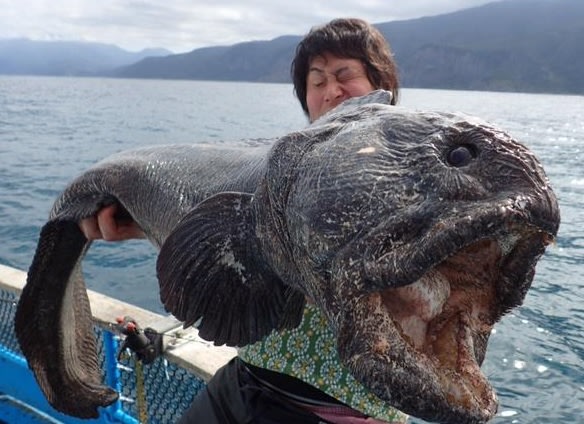You know, one day people are going to have to learn the difference between movies and real life!

A monster wolffish caught off the coast of Japan's island of Hokkaido is not the result of radiation from the 2011 Fukushima nuclear disaster – it is just a big fish, a scientist has said. Timothy Mousseau, one of the world's leading experts on the effects of nuclear contamination on wildlife, told IBTimes UK it is "extremely unlikely" the contamination had anything to do with the wolffish's unusually large size.
"First and foremost simply because usually the effects of mutations are to reduce growth rates to make things smaller," he said. "They grow less efficiently, they're less capable of catching food and they tend to not live as long. Most of the effects of increased mutations are deleterious. Very very few mutations lead to extra-large size."
Wolffish normally grow up to around 110cm – the largest ever recorded was 150cm. However, the one caught by Hiroshi Hirasaka (images of which he shared on Twitter) was around 200cm in length. The pictures led some people to suggest a link with the Fukushima disaster, the largest nuclear accident since the Chernobyl explosion of 1986.
But this is not the case, Mousseau said. "It's just a really lucky catch by this fisherman. If you look hard and long enough there's always a few that manage to survive long enough to achieve these large sizes. Fish have what we call indeterminate growth, which means as long as they are living they tend to get bigger and bigger and bigger. So there's usually a good relationship between size and age. If there's enough of them out there and nothing eating them and no one fishing for them, then they can live long enough to reach large sizes."
"The good news is about half of the radiation has already disappeared
because of natural decomposition and decay," he said. "That combined
with natural processes are leading to the decline in the level of
radiation.
"The bad news is that the most contaminated part of the area, which is a significant land area, will be contaminated for decades if not centuries, so we will continue to see the effects for some time especially in the contaminated areas."
And for all you conspiracy theorists out there: WHAT aren't they telling us?? Hmm?
By Hannah Osborne | International Business Times

A monster wolffish caught off the coast of Japan's island of Hokkaido is not the result of radiation from the 2011 Fukushima nuclear disaster – it is just a big fish, a scientist has said. Timothy Mousseau, one of the world's leading experts on the effects of nuclear contamination on wildlife, told IBTimes UK it is "extremely unlikely" the contamination had anything to do with the wolffish's unusually large size.
"First and foremost simply because usually the effects of mutations are to reduce growth rates to make things smaller," he said. "They grow less efficiently, they're less capable of catching food and they tend to not live as long. Most of the effects of increased mutations are deleterious. Very very few mutations lead to extra-large size."
Wolffish normally grow up to around 110cm – the largest ever recorded was 150cm. However, the one caught by Hiroshi Hirasaka (images of which he shared on Twitter) was around 200cm in length. The pictures led some people to suggest a link with the Fukushima disaster, the largest nuclear accident since the Chernobyl explosion of 1986.
But this is not the case, Mousseau said. "It's just a really lucky catch by this fisherman. If you look hard and long enough there's always a few that manage to survive long enough to achieve these large sizes. Fish have what we call indeterminate growth, which means as long as they are living they tend to get bigger and bigger and bigger. So there's usually a good relationship between size and age. If there's enough of them out there and nothing eating them and no one fishing for them, then they can live long enough to reach large sizes."
While this is no Godzilla-esque
mutant wolffish, wildlife in Fukushima has been badly affected by the
radiation leak. Mousseau said he and other scientists have been
monitoring bird populations in Fukushima since the disaster and have
seen major declines in numbers in the more contaminated areas. They are
also looking at mice and moths, and he said the effects of the disaster
will be seen for many more years.
"The bad news is that the most contaminated part of the area, which is a significant land area, will be contaminated for decades if not centuries, so we will continue to see the effects for some time especially in the contaminated areas."
And for all you conspiracy theorists out there: WHAT aren't they telling us?? Hmm?

No comments:
Post a Comment